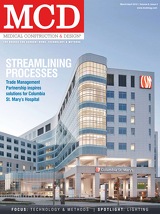Medical Construction & Design (MCD) is the industry's leading source for news and information and reaches all disciplines involved in the healthcare construction and design process. To view more past issues go to: http://mcdmag.epubxpress.com
Page 57 of 70
TECHNOLOGY & METHODS
level concourse to facilitate easy, convenient access to registration for inpatient and outpatient services. Three color-coded specialty institutes are used to guide pa- tients to destination points, making it easy for patients to access care on a large hospital campus. Other design concepts to improve patient outcomes
include: > Intuitive grouping of specialists and services in the institutes to deliver patient care in a more timely and ef- fi cient manner > Using views to provide reference points and improve wayfi nding in the hospital > Mitigating noise through the use of sound-absorbing materials in the walls and ceiling tiles > Providing dedicated space to enable family members to sleep over in patient rooms > Allowing patients to control the lighting and tempera- ture in their rooms
IMPROVING PATIENT OUTCOMES
HOK planned the campus to deliver appropriate levels of care in the ideal setting. While more convenient for pa- tients, it also optimizes hospital resources. The outpatient surgery and procedure area is a signifi cant departure from a traditional hospital layout. The same concourse that provides patients one point of entry for all episodes in their continuum of care also consolidates the areas where staff prepares patients for surgery and monitors their recovery. The design facilitates better nurse supervi- sion and decreases the amount of staff required for these areas. The shared area also gives the hospital the ability to optimize utilization of expensive medical equipment. Within the hospital there are 14 surgical suites, 45 emergency department patient rooms, 12 burn center rooms and 32 patient rooms for the Sacred Heart Rehabili- tation Institute. The adjoining Women's Hospital includes 11 labor, delivery and recovery rooms, 26 mother/baby patient rooms and 18 patient areas for neonatal intensive care. Flexibility is also an asset to future hospital expan- sion. Standard patient rooms are designed to be easily converted into intensive-care rooms with little effort. TMP is especially useful for large-scale healthcare con- struction projects, where the owner wants greater control over achieving goals by avoiding the contractual rigidity of integrated project delivery. As belt tightening continues, it only makes sense to leverage the skills of subcontractors, who are highly experienced in healthcare projects, to put the touches on plans to deliver the best outcomes.
William Wahle is vice president of HOK Healthcare Group.
COLUMBIA ST. MARY'S HOSPITAL Architect: HOK
Associate Architect: Kahler Slater Program Manager: M-3 LLC
General Contractor: Barton Malow/C. G. Schmidt Structural Engineer: HOK MEP: Affi liated Engineering, Inc./ Ring & Duchateau, LLP Interior Design: HOK Landscape Architect: HOK
www.mcdmag.com
March/April 2012 | Medical Construction & Design 53
